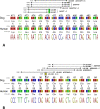Whole exome sequencing analysis of canine urothelial carcinomas without BRAF V595E mutation: Short in-frame deletions in BRAF and MAP2K1 suggest alternative mechanisms for MAPK pathway disruption
- PMID: 37079639
- PMCID: PMC10153751
- DOI: 10.1371/journal.pgen.1010575
Whole exome sequencing analysis of canine urothelial carcinomas without BRAF V595E mutation: Short in-frame deletions in BRAF and MAP2K1 suggest alternative mechanisms for MAPK pathway disruption
Abstract
Molecular profiling studies have shown that 85% of canine urothelial carcinomas (UC) harbor an activating BRAF V595E mutation, which is orthologous to the V600E variant found in several human cancer subtypes. In dogs, this mutation provides both a powerful diagnostic marker and a potential therapeutic target; however, due to their relative infrequency, the remaining 15% of cases remain understudied at the molecular level. We performed whole exome sequencing analysis of 28 canine urine sediments exhibiting the characteristic DNA copy number signatures of canine UC, in which the BRAF V595E mutation was undetected (UDV595E specimens). Among these we identified 13 specimens (46%) harboring short in-frame deletions within either BRAF exon 12 (7/28 cases) or MAP2K1 exons 2 or 3 (6/28 cases). Orthologous variants occur in several human cancer subtypes and confer structural changes to the protein product that are predictive of response to different classes of small molecule MAPK pathway inhibitors. DNA damage response and repair genes, and chromatin modifiers were also recurrently mutated in UDV595E specimens, as were genes that are positive predictors of immunotherapy response in human cancers. Our findings suggest that short in-frame deletions within BRAF exon 12 and MAP2K1 exons 2 and 3 in UDV595E cases are alternative MAPK-pathway activating events that may have significant therapeutic implications for selecting first-line treatment for canine UC. We developed a simple, cost-effective capillary electrophoresis genotyping assay for detection of these deletions in parallel with the BRAF V595E mutation. The identification of these deletion events in dogs offers a compelling cross-species platform in which to study the relationship between somatic alteration, protein conformation, and therapeutic sensitivity.
Copyright: © 2023 Thomas et al. This is an open access article distributed under the terms of the Creative Commons Attribution License, which permits unrestricted use, distribution, and reproduction in any medium, provided the original author and source are credited.
Conflict of interest statement
The authors have declared that no competing interests exist.
Figures




Similar articles
-
Systemic treatments for metastatic cutaneous melanoma.Cochrane Database Syst Rev. 2018 Feb 6;2(2):CD011123. doi: 10.1002/14651858.CD011123.pub2. Cochrane Database Syst Rev. 2018. PMID: 29405038 Free PMC article.
-
Can a Liquid Biopsy Detect Circulating Tumor DNA With Low-passage Whole-genome Sequencing in Patients With a Sarcoma? A Pilot Evaluation.Clin Orthop Relat Res. 2025 Jan 1;483(1):39-48. doi: 10.1097/CORR.0000000000003161. Epub 2024 Jun 21. Clin Orthop Relat Res. 2025. PMID: 38905450
-
Comprehensive mutational profiling identifies new driver events in cutaneous leiomyosarcoma.Br J Dermatol. 2025 Jan 24;192(2):335-343. doi: 10.1093/bjd/ljae386. Br J Dermatol. 2025. PMID: 39392932
-
Immunohistochemistry as a reliable method for detection of BRAF-V600E mutation in melanoma: a systematic review and meta-analysis of current published literature.J Surg Res. 2016 Jun 15;203(2):407-15. doi: 10.1016/j.jss.2016.04.029. Epub 2016 Apr 23. J Surg Res. 2016. PMID: 27363650
-
Effective detection of BRAFV595E mutation in canine urothelial and prostate carcinomas using immunohistochemistry.Vet Comp Oncol. 2024 Jun;22(2):295-302. doi: 10.1111/vco.12978. Epub 2024 Apr 24. Vet Comp Oncol. 2024. PMID: 38659202
Cited by
-
BRAFΔβ3-αC in-frame deletion mutants differ in their dimerization propensity, HSP90 dependence, and druggability.Sci Adv. 2023 Sep;9(35):eade7486. doi: 10.1126/sciadv.ade7486. Epub 2023 Sep 1. Sci Adv. 2023. PMID: 37656784 Free PMC article.
-
Novel genomic prognostic biomarkers for dogs with cancer.J Vet Intern Med. 2023 Nov-Dec;37(6):2410-2421. doi: 10.1111/jvim.16893. Epub 2023 Oct 6. J Vet Intern Med. 2023. PMID: 37801037 Free PMC article.
-
Leading the pack: Best practices in comparative canine cancer genomics to inform human oncology.Vet Comp Oncol. 2023 Dec;21(4):565-577. doi: 10.1111/vco.12935. Epub 2023 Oct 1. Vet Comp Oncol. 2023. PMID: 37778398 Free PMC article. Review.
-
Cross-species oncogenomics offers insight into human muscle-invasive bladder cancer.Genome Biol. 2023 Aug 28;24(1):191. doi: 10.1186/s13059-023-03026-4. Genome Biol. 2023. PMID: 37635261 Free PMC article.
-
Polypoid Cystitis: A Retrospective Case-Series of 112 Dogs.J Vet Intern Med. 2025 May-Jun;39(3):e70049. doi: 10.1111/jvim.70049. J Vet Intern Med. 2025. PMID: 40375558 Free PMC article.
References
-
- Knapp DW, Dhawan D, Ramos-Vara JA, Ratliff TL, Cresswell GM, Utturkar S, et al.. Naturally-Occurring Invasive Urothelial Carcinoma in Dogs, a Unique Model to Drive Advances in Managing Muscle Invasive Bladder Cancer in Humans. Front Oncol. 2019;9:1493. Epub 2020/02/11. doi: 10.3389/fonc.2019.01493 ; PubMed Central PMCID: PMC6985458. - DOI - PMC - PubMed
-
- Decker B, Parker HG, Dhawan D, Kwon EM, Karlins E, Davis BW, et al.. Homologous Mutation to Human BRAF V600E Is Common in Naturally Occurring Canine Bladder Cancer—Evidence for a Relevant Model System and Urine-Based Diagnostic Test. Mol Cancer Res. 2015;13(6):993–1002. Epub 2015/03/15. doi: 10.1158/1541-7786.MCR-14-0689 ; PubMed Central PMCID: PMC4470794. - DOI - PMC - PubMed
Publication types
MeSH terms
Substances
LinkOut - more resources
Full Text Sources
Medical
Research Materials
Miscellaneous

